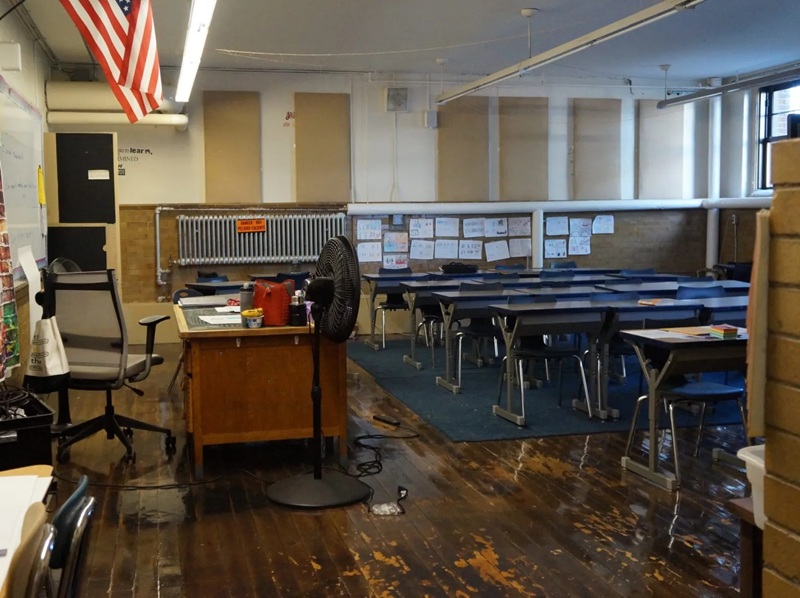Because of one bad policy move after another, Massachusetts has been backsliding on education for more than a decade. Will we face up to this reality and change course?
School reform led to remarkable student achievement gains, but we’ve been in a 15-year decline
by Charles Chieppo and Jamie Gass
October 9, 2025
New MCAS results reveal that the performance of Massachusetts public-school students remains far below pre-pandemic levels and shows few signs of improvement.

A small classroom inside the 109-year-old Pickering Middle School in Lynn. (Photo by Hallie Claflin)
The data follow National Assessment of Educational Progress (NAEP) scores released earlier this year in which the Commonwealth’s students scored at a 20-year low.
Compare these results to the years following passage of a 1993 education reform law that ushered unprecedented improvements in student achievement and came to be known as the “Massachusetts Miracle.” By 2007, the Commonwealth’s eighth graders tied for best in the world on international science testing.
Now, nearly 15 years into a precipitous decline in educational outcomes, it’s hard not to wonder whether Massachusetts leaders will wait for all the gains from education reform to be wiped out before they do something about it.
The Education Reform Act combined a significant investment in public education – particularly in less affluent school districts – with high academic standards and accountability for everyone in the system.
Money is important, but it isn’t the problem here. The Commonwealth’s 2019 Student Opportunity Act adds over $875 million to annual education appropriations, again focused on promoting equity by providing increased funding for students from disadvantaged backgrounds, to what was already one of the nation’s best-funded public-school systems. Massachusetts schools also received nearly $2.3 billion in federal pandemic relief money.
This year, K-12 public education will receive nearly $500 million in receipts from the tax increase on high earners that state voters approved in 2022. All told, state and local taxpayers are spending about $18 billion on public schools.
The money is still flowing, but standards and accountability haven’t fared so well. In 2010, Massachusetts jettisoned the nation’s best English language arts and math standards, replacing them with national academic standards known as Common Core that dramatically cut the amount of literature students read and slowed their progression to higher mathematics study.
On accountability, the Commonwealth eliminated an independent agency that performed comprehensive audits of state school districts in 2008, replacing it with… not much. Last year voters eliminated the requirement that students pass MCAS English, math and science tests to graduate from high school.
Perhaps education reform’s single biggest success was the Commonwealth’s charter public schools. Stanford University’s Center for Research on Education Outcomes found that Boston charters performed the best of 41 urban charter sectors it studied. The Brookings Institution found that Boston’s charter schools achieved some of the largest academic gains ever documented. But charters have been stalled since a bid to increase their number failed at the ballot box in 2016.
Some charter schools need to get their own houses in order. Performance at too many of them has declined since their embrace of “social justice education.” Such equity-centric programs aren’t, by definition, harmful, but in some charters they have taken the place of delivering the rich liberal arts curriculum that is the surest path to justice.
Now another education reform success, the Commonwealth’s outstanding vocational-technical schools, are in the crosshairs of reform opponents because they’re drawing more and more students from traditional public high schools.
The deterioration in performance became clear after the Commonwealth adopted Common Core in 2011. By 2019, Massachusetts NAEP scores fell by more than all but 17 states in math and all but 14 in reading. Then the Commonwealth’s students had among the nation’s largest declines during the pandemic. Rather than recovering at least some of that ground post-pandemic, the decline continues.
MCAS results reveal that the overall portion of students meeting expectations fell from half before the pandemic to 42 percent now. The portion of students who failed rose from 11 percent to 18 percent.
Only 39 percent met or exceeded expectations on the just-unveiled 8th-grade civics test. In these tumultuous political times, the civics results give chilling new meaning to the story of the woman outside the Constitutional Convention in Philadelphia in 1787, who asked Benjamin Franklin, “What have we got, a republic or a monarchy?” “A republic,” Franklin replied, “if you can keep it.”

After nearly 15 years of decline, the question is whether things have finally gotten bad enough for state leaders to return to the high standards, accountability, and strategic access to high quality choices that were pillars of the most successful education reform in modern American history.
Charles Chieppo is a senior fellow and Jamie Gass is director of PioneerEducation at Pioneer Institute, a Boston-based public policy think tank.

CommonWealth Voices is sponsored by The Boston Foundation.
The Boston Foundation is deeply committed to civic leadership, and essential to our work is the exchange of informed opinions. We are proud to partner on a platform that engages such a broad range of demographic and ideological viewpoints.
